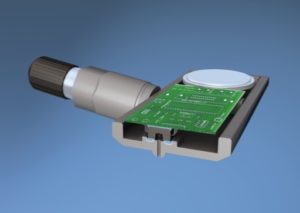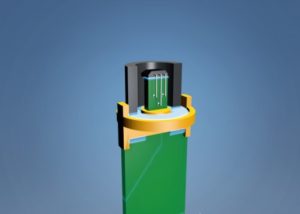Bonding of automotive sensors
Today, there are on average around 100 sensors in every car, and the number is increasing daily. Their applications include safety, comfort and powertrain. A large number of these sensors are fixed by gluing and protected by encapsulation. In the automotive industry, the operating requirements are high and the adhesives used have to work for a long time with maximum reliability, especially in difficult environments, such as the engine compartment.
Here are some tips on the families of adhesives suitable for different types of sensors: Sensors are found wherever there is a need to detect and transmit information within the vehicle. Their main function is usually to measure physical variables such as temperature, pressure, position or speed. These signals are then transmitted to control systems or electronic calculation units. Precise mounting is therefore essential for accurate measurement. The sensors must also be protected to withstand difficult operating conditions, especially for systems that measure pressure or oil levels in the direct vicinity of the engine block. The adhesives and encapsulants used for these functions must offer first-class mechanical properties, chemical resistance and thermal resistance. Among the many sensors used in the automotive industry are those dedicated to parking assistance, tyre pressure monitoring, speed, position, flow, temperature or air pressure measurements within the intake or exhaust systems (TMAP sensors). Easy and safe parking For parking assistance sensors, the accuracy of the information given to the driver is paramount. It is this information that helps the driver manoeuvre the car into a tight space safely. If the sensor fails, it can cost the driver dearly. Therefore, it is important that the adhesive used, in addition to withstanding the mechanical stresses of vibration, has suitable acoustic properties to reliably transmit the ultrasound signal without distorting it. Light-curing epoxy resins meet these requirements and allow short cycle times for mass production. Their chemical structure also gives them excellent performance in certification tests such as resistance to salt spray or thermal shock. Tyres under control
Sensors are also used as warning triggers when it comes to tyre pressure. They provide visual and acoustic information as soon as the pressure in one of the tyres drops abnormally. They play an important role in terms of driving safety, fuel consumption or even wear and tear. If a tyre loses pressure, the risk of an accident is multiplied because the braking distance is considerably longer and stability in curves is also degraded. The epoxy resins used for this application must be extremely resistant to automotive fluids, salt spray and detergents. The mechanical behaviour of these adhesives has been validated in the laboratory by vibration and shock tests representative of vehicle use. This allows them to be used on many vehicles today.
Tyres under control
Sensors are also used as warning triggers when it comes to tyre pressure. They provide visual and acoustic information as soon as the pressure in one of the tyres drops abnormally. They play an important role in terms of driving safety, fuel consumption or even wear and tear. If a tyre loses pressure, the risk of an accident is multiplied because the braking distance is considerably longer and stability in curves is also degraded. The epoxy resins used for this application must be extremely resistant to automotive fluids, salt spray and detergents. The mechanical behaviour of these adhesives has been validated in the laboratory by vibration and shock tests representative of vehicle use. This allows them to be used on many vehicles today.
 Guaranteed positions.
Vehicles are increasingly incorporating sensors using the Hall effect to detect component positions or speeds. These sensors are used on various components such as EGR valves, wheel hubs or actuators. For these applications, adhesives with dual curing systems, UV/anaerobic light or UV/heat, are particularly suitable in terms of process. They offer the possibility of fast pre-fixing and safe curing in hidden areas. These adhesives are highly resistant to media such as oil, petrol and brake fluids and give good thermo-mechanical results in the Reflow tests (JEDEC) required for electronic processes or in vibration and drop tests.
Guaranteed positions.
Vehicles are increasingly incorporating sensors using the Hall effect to detect component positions or speeds. These sensors are used on various components such as EGR valves, wheel hubs or actuators. For these applications, adhesives with dual curing systems, UV/anaerobic light or UV/heat, are particularly suitable in terms of process. They offer the possibility of fast pre-fixing and safe curing in hidden areas. These adhesives are highly resistant to media such as oil, petrol and brake fluids and give good thermo-mechanical results in the Reflow tests (JEDEC) required for electronic processes or in vibration and drop tests.
 Optimum mixing for less pollution
Mass flow meters, temperature sensors and absolute air pressure sensors in the intake manifold (TMAP) are part of the range of systems used to reduce pollutant emissions. These sensors are located in the engine compartment, or more precisely in the air intake system. The function of the Mass Air Flow (MAF) sensor is to measure and transmit to the engine management system the amount of mass air intake. This value is required in both petrol and diesel engines for the calculation of various parameters. These mass air flow meters are more accurate than TMAP sensors, which determine air masses by measuring intake air temperatures and pressures. To protect these sensors, very high reliability epoxy resins are used. They give excellent results in the most demanding automotive tests. They are resistant to oil, petrol and brake fluid and can withstand sudden temperature changes from -40 °C to +160 °C. Even after storage at these temperatures, encapsulations made with these resins show no cracks. No interaction between transmission oils or exhaust condensates and these encapsulation resins has been detected in operation.
Optimum mixing for less pollution
Mass flow meters, temperature sensors and absolute air pressure sensors in the intake manifold (TMAP) are part of the range of systems used to reduce pollutant emissions. These sensors are located in the engine compartment, or more precisely in the air intake system. The function of the Mass Air Flow (MAF) sensor is to measure and transmit to the engine management system the amount of mass air intake. This value is required in both petrol and diesel engines for the calculation of various parameters. These mass air flow meters are more accurate than TMAP sensors, which determine air masses by measuring intake air temperatures and pressures. To protect these sensors, very high reliability epoxy resins are used. They give excellent results in the most demanding automotive tests. They are resistant to oil, petrol and brake fluid and can withstand sudden temperature changes from -40 °C to +160 °C. Even after storage at these temperatures, encapsulations made with these resins show no cracks. No interaction between transmission oils or exhaust condensates and these encapsulation resins has been detected in operation.

 Conclusion:
As these examples show, it is essential to adapt the type of adhesive to the thermal, mechanical and chemical conditions under which the sensor operates. But even for the most demanding applications, there are suitable adhesives and encapsulation solutions to ensure optimal performance and the high level of reliability required by these systems
» Back to our news
Conclusion:
As these examples show, it is essential to adapt the type of adhesive to the thermal, mechanical and chemical conditions under which the sensor operates. But even for the most demanding applications, there are suitable adhesives and encapsulation solutions to ensure optimal performance and the high level of reliability required by these systems
» Back to our news 